15 Types of Grasshoppers to Look for Out in the Wild
Author: Jen Worst | Editor: Omar Alonso
Review & Research: Jen Worst & Chris Miller

When we think about any types of grasshoppers, we mostly recall two kinds of memories. One involves the sweet childhood that we spent running around the insect while the other one is scary, involving swarms of locusts that devour every plant in sight. All of us have surely encountered these little creatures, whatever the scenario is.
There are many kinds of grasshoppers with mostly green, black, olive, or brown bodies and are found only in warm areas. You can easily identify them from two sets of wings and long legs. Grasshoppers also feature big brown or green eyes and short antennae.
Here we will get to know this insect a little more and talk about some of the common grasshopper types or species with their unique characteristics. Let's dive in.
15 Types of Grasshoppers
Grasshoppers belong to the order Orthoptera that contains more than 10,000 grasshopper species. There are mainly two families or types of grasshoppers depending on the size of the antennae: Short-horned grasshoppers and Long-horned grasshoppers.
These two families are further divided into many subfamilies containing thousands of species. Let's look at the two families and some of their subfamilies.
Short-Horned Grasshopper
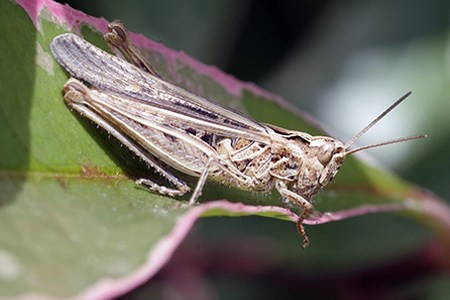
These grasshoppers belong to the Acrididae family and are identified by their short but thick antennae, which are longer than their bodies. In the United States, there are more than 130 species of short-horned grasshoppers.
You'll find this type mainly on the ground, grasslands, and herbaceous plants. They are very rarely found on tress.
Another identifying character of this type is the 4-valved ovipositor in the female grasshoppers. The insects lay approximately 100 eggs through this tubular appendage. Most short-horned grasshoppers are green, black, tan, or brown, which helps the insects camouflage in the grasses.
All the species are 5 mm to 10 cm long and have 3 pairs of long legs featuring 3-segmented tarsi. Also, the antennae on the head have a maximum of 30 segments. Interestingly, flightless species in this type lacks wings. The male rubs their front wings to make noises to attract the females.
The short-horned species are herbivorous and include some of the most destructive pests, commonly known as locusts. Below are the most common subfamilies of short-horned grasshoppers.
Slant-Faced Grasshoppers
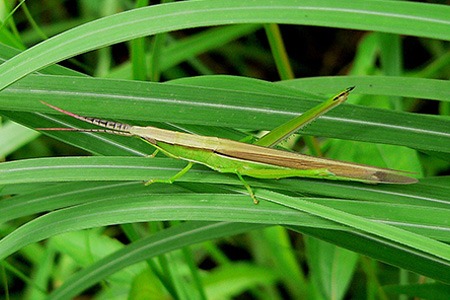
As the name suggests, Hyperacanthus brevis have a characteristic slanted face. The face is noticeably slanted in most species, whereas some have weakly slanted, vertical faces. The insects feature flat, sword-like antennae and almost colorless hind wings.
They are a large, long-horned species of insect known for their unique appearance. Donning a slender body and long, slender legs, it has a wide, flat face and large compound eyes on either side of the head. It’s light brown in color with darker brown stripes on the sides.
Grasshoppers with slant face belong to the Acridinae family, and most members of this group feed on grasses and plants.
However, some species show interest in a large variety of other food. The insects grow 25-39 mm in length, and the females lay eggs during the fall that hatches in spring.
Slant-faced grasshoppers lack stridulatory pegs and a postural spine that distinguishes them from other subfamilies. You can spot them near wet meadows, prairie remnants, and marshes.
Since these types of grasshoppers don't form large groups, they won't cause any severe harm to your plants and vegetation. Two slant-faced grasshopper species are Metaleptea brevicornis and Syrbula admirabilis.
You’d be astonished to know that they are known for their distinctive long, curved horns, which they use to fight rivals and attract mates. On top of that, they are also known for their unique ability to jump great distances, which makes them a popular insect for children to observe.
They have short antennae, and males have long, bristle-like appendages at the ends of their abdominal segments. It is most commonly found in deserts and arid regions, where it is subject to the harshest and driest of conditions.
Band-Winged Grasshoppers
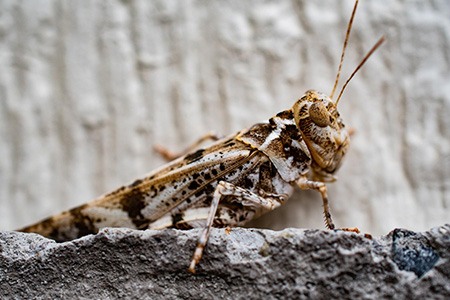
These grasshoppers came from the family Oedipodinae and earned their name for being the only short-horned type that produces crackling sounds while flying. Only the male ones make the sounds with the help of a row of pegs situated on their hind legs.
Band-winged grasshoppers have a vertical face and a pointed posterior edge. The insects showcase various beautiful colors on their wings that remain hidden while they rest and therefore help to blend in the grasses.
However, some of the species have regular brown or green color, and some are clear-winged. Mostly the wings have red or bright yellow colors with black on the edges.
The kinds of grasshoppers use the hues rather wisely and expose them when threatened for startle and confuse the predator. You can identify this type from the sharp median ridge located on the dorsal surface just below the head.
Many species of this group feed on xeric weedy fields, whereas some are considered to be important locusts. The grasshoppers measure 36-55 mm in length. Two band-winged grasshopper species are Locusta migratory and Chortophaga viridifasciata.
They live on the savannas of northern South America and northern Brazil, at altitudes of about 300–1500 m. These interesting grasshoppers tend to move about in grassy fields or forest clearings or at the edges of clearings in the forest.
The male band-winged grasshopper has an unusual mating behavior. It engages in a courtship dance that common in more evolved animals.
Spur-Throated Grasshoppers
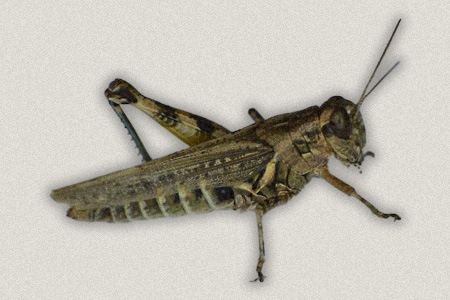
These types of grasshoppers are mostly found in North America, and they're a part of the Cyrtacanthacridinae family. The insects have a cone-like projection between the two front legs as an identifying feature.
Moreover, their nearly vertical face and large swarms make it easier to spot this type of grasshoppers. In general, the spur-throated grasshopper is about 5 inches long. Its body is grayish-brown in color, though these grasshopper varieties can be found in many colors.
There are about 500 species of spur-throated grasshoppers in the world. They are found in a wide variety of habitats in the Americas, including deserts, mountains, forests, and fields.
Generally, this group includes a lot of colorful species. Green, olive, yellow, and orange are the most common body colors that feature some shades of red and brown on the wings. Some species have vividly colored spots or blotches all over their bodies.
The female members of this group lay only 20 or fewer eggs at a time. Eggs are directly deposited on the ground, and the female stays on them throughout the winter season. The eggs hatch in the spring or early summer, and the young nymphs undergo 5 metamorphoses to turn into adults.
You can find these types of grasshoppers mostly in open areas. Some species always keep moving from place to place, and a few of them are destructive as they don't spare any vegetation that comes their way.
Here are two main destructive types of spur-throated grasshoppers are Locusts and Lubber Grasshoppers, seen below.
Locusts

Grasshoppers belong to the genus Schistocerca and are known worldwide as locusts, thought there's a slight difference between locusts and grasshoppers. Despite being solitary in the initial stages, locust nymphs form large swarms that fly towards the plants and vegetation to destroy them entirely.
The locust is a small, brown, three-winged insect that is often seen in large numbers. They are known for their large migrations and are often a sign of an approaching infestation.
A lot of times, they can also cause large economic damage to crops and orchards. They feed on grasses and other plants and have the ability to cause extensive damage to agricultural fields.
These menacing grasshoppers are known for their ability to form large swarms and cause widespread devastation on their host plants. They are considered among the most destructive grasshoppers in the world.
Lubber Grasshoppers
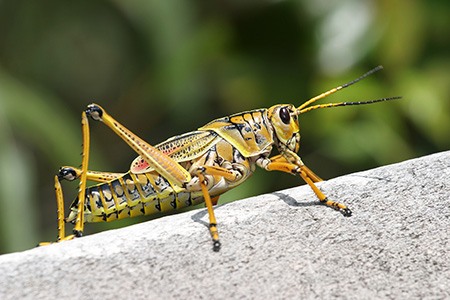
These grasshoppers are mainly scrawlers and tend to form swarms for causing harm to crops and vegetables. Some lubber species grow up to 5-7cm and display many vibrant colors on their bodies.
Lubber grasshoppers are large, orange, and have long legs and antennae. They’re often seen eating grass, and they’re commonly raised as livestock. Unfortunately, they’re also known to spread plant pathogens and pests when they eat infected grass.
The lubber grasshopper is a short-lived species of grasshopper found in warm temperate and tropical grasslands. They are often seen skipping through grasslands, chasing after gophers, and racing other grasshoppers for mates.
Crickets

Though there are many different types of grasshoppers that are called crickets by the common person, it's truly the family Gryllidae that are legitimate types of crickets. You'll hear about field crickets, ground crickets, bush crickets, and even tree crickets, where their names describe their typical environment.
When you hear a cricket singing at night, know that you're only hearing males. Only the males have the forewings that are used in creating the chirping sound. Crickets have your typical wings but they still mainly are jumping critters.
It's estimated that the general field cricket can leap as many as 20 times their own body length, which is an incredible feat even if it ends up not being that huge of a distance to us.
Long-Horned Grasshoppers
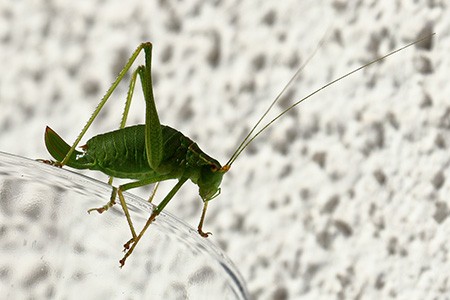
Long-horned types of grasshoppers hail from the family Tettigoniidae consisting of almost 6000 species. On the head portion, tettigoniids feature thin antennae that rise longer than their bodies.
Apart from the longhorn, you can identify the species from their auditory organ called 'Tympanum' situated at the front leg's tibia region. Female members of the species have a characteristic laterally compressed ovipositor.
Most grasshoppers of this type are green which helps them blend into the green vegetation. Although most long-horned grasshoppers are herbivores and feed on herbs and plants, some are predators.
Male tettigoniids rub their wings to create exclusive songs. The females lay their eggs on the leaves and stems of plants. Here are the most common subfamilies of long-horned grasshoppers.
Bush Katydids
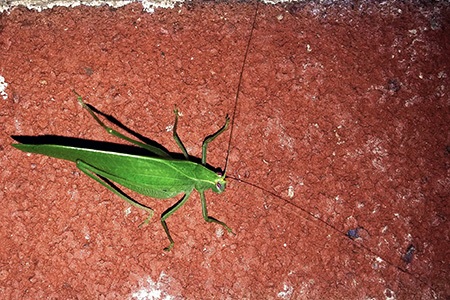
Bush katydids are members of the subfamily Phaneropterinae and are mostly found in deciduous plants, shrubbery, and woodlands. The hindwings of the species are angled, broader, and longer than the forewings. Most species range from 36 to 50 mm in size.
The insects produce only one generation each year as the female members lay eggs near the edge of the plant leaves. During spring, the eggs hatch, and young nymphs come out with their unique black and white spotted antennae.
While the adults feed on broad leaves of woody plants, nymphs prefer flowers and herbaceous plants. Two species of bush katydids are Scudderia sp. and Amblycorypha sp.
Shield-Back Katydid
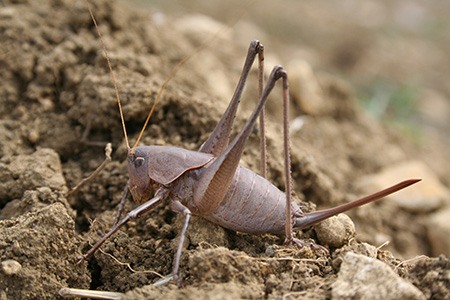
The shield-back katydid is a species of insect that makes its home in the forests of the eastern United States. It belongs to the family Tettigoniidae, which is better known as the katydids.
These grasshopper varieties are also known as the collared katydid because of the white collars on their dark wings. The female shield-back katydid is larger than the male and can be identified by the dark brown spot at the tip of her abdomen.
It is mostly brown with white stripes and spots. The female is larger than the male. The insect’s vernacular name comes from the shape of its back, which is like a shield when viewed from the side.
Cone-Headed Grasshoppers
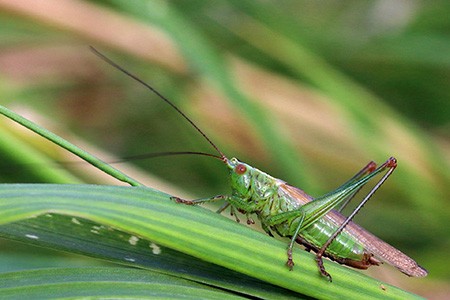
This species of grasshopper is found in the southwestern United States and northern Mexico. The base of the cone-shaped body is black, while the top and sides are of a tan color.
The majority of the cone-shaped body is covered in short, brown-colored hairs, but the head and neck are hairless. Also, the front part of the cone-shaped body is used as a snorkel, and the back part is used for breathing.
Meadow Grasshoppers
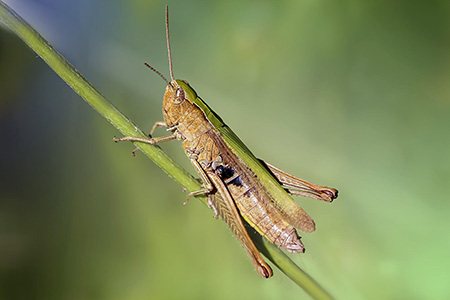
These types of grasshoppers are a part of the subfamily Conocephalinae. A fairly large head and reddish or yellow-orange eyes are the easiest way to identify them. Moreover, the insects have greyish brown spots circling their eyes, and the ovipositor on females is usually sword-like with upward curves.
Meadow grasshoppers are usually only 1-inch long and appear bulkier than other species. Although the whole body of these grasshoppers is mostly green or olive, the top surface of the body and the wings have shades of brown or grey.
The male members have their unique songs that sound like high-pitched buzzing. You can spot these kinds of grasshoppers near ill-maintained ponds, meadows, or lakes. Some species also inhabit grassy areas.
Meadow grasshoppers feed on leaves and other plant materials. Some of them are scavengers feeding on various organic materials. Two species of meadow grasshoppers are Chorthippus parallelus and Orchelimum sp.
Predaceous Katydids
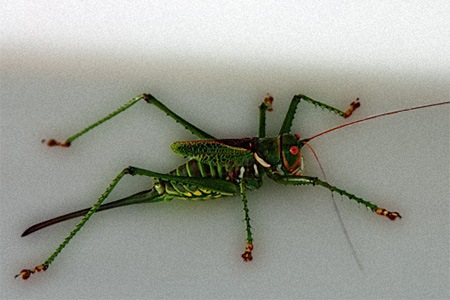
Among all the types we have talked about, this is undoubtedly unique. Predaceous katydids are from the subfamily Tettigoniinae and grow 18-50 mm in size. The identifying characteristic of these insects is the shield-like pronotum, for which they are also known as shield-back katydid.
Unlike most grasshoppers, this type is flightless as some of them possess non-functional wings, and some don't have any wings at all.
Predaceous grasshoppers are good climbers, and you can find them on trees, farmlands, shrubs, and grounds. Most of them are black or brown, while some exceptions have green bodies.
Almost all the species of this these different kinds of grasshoppers feed on both plants and insects. Some scavenge dead insects, plants, or even animals.
They prefer animal protein over plant materials, and some also capture live prey. Two species of predaceous grasshoppers are Atlanticus testaceous and Pediodectes haldemani.
Migratory Grasshoppers
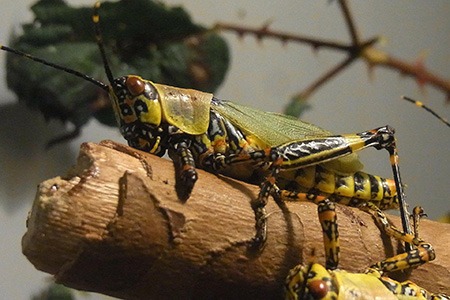
The migratory grasshopper is a beloved symbol of the West in the United States. They're also a pest, a species that causes millions of dollars in damage to crops every year.
Migratory grasshoppers go by many names: hoppers, locusts, and leapers are all common names. Yes, locusts are migratory grasshoppers too. They are scientifically classified in the family Acrididae and are sometimes referred to as short-horned grasshoppers.
This unique insect has the ability to travel across continents, which makes it all the more fascinating. Each Spring and Fall, billions of these bugs cross continents in search of new breeding territory.
The migration of these types of grasshoppers is so massive that it has an impact on the weather, causing rain and even tornadoes in some areas.
A fun fact about these insects is that the first species to arrive each Spring are the migratory grasshoppers. These insects have a wide range, but they can be found almost anywhere in the world. They often migrate over thousands of miles in a single year, sometimes with the help of the wind.
Pygmy Grasshoppers
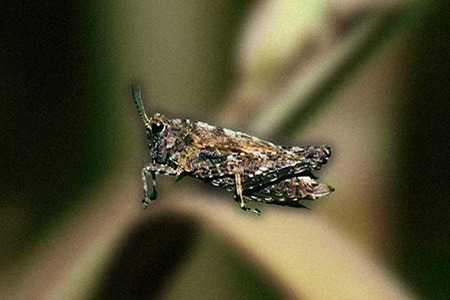
The pygmy grasshopper, also known as the short-horned grasshopper, is a species of insect that can be found in many different regions of the United States. They’re a family of insects in the order Orthoptera. They are named for their small size, but they are not the smallest grasshoppers.
Most species are less than an inch long, and some are so small that they can only be seen with a microscope. They are also called collared grasshoppers because of the collars of dark scales on their necks.
These varieties of grasshoppers are the smallest type of grasshopper in the world. It is only about half an inch long. The pygmy grasshopper is brownish in color and has large eyes. It lives in the desert and can survive for long periods of time without water.
We must say, it’s a fascinating insect. It’s one of the smallest insects in the world and can fit on the head of a needle. They live in large groups in the desert and come out at night to hunt for food.
The pygmy grasshopper is unique in that it is a species of insect that is able to jump and leap, as opposed to other species of grasshopper, which are only able to move by crawling.
You can find them in a variety of different habitats and climates throughout the United States, ranging from grassy fields to forests and even deserts. The pygmy grasshopper is known for being a very prolific species of insect, with large populations often being found in the same area.
Types of Grasshoppers to Identify
Unfortunately, very few people recognize the usefulness and diversity of these small insects. Grasshoppers help to control unwanted vegetation growth, and they also make a good diet for birds, rodents, and even coyotes. However, you must be careful about those large swarms of grasshoppers that cause only destruction.
From all the different types of grasshoppers, we discussed the most common and unique ones in this writeup. Presumably, grasshoppers have been around for 200 million years, and now we can't think of our summers without their noisy 'singing.'



